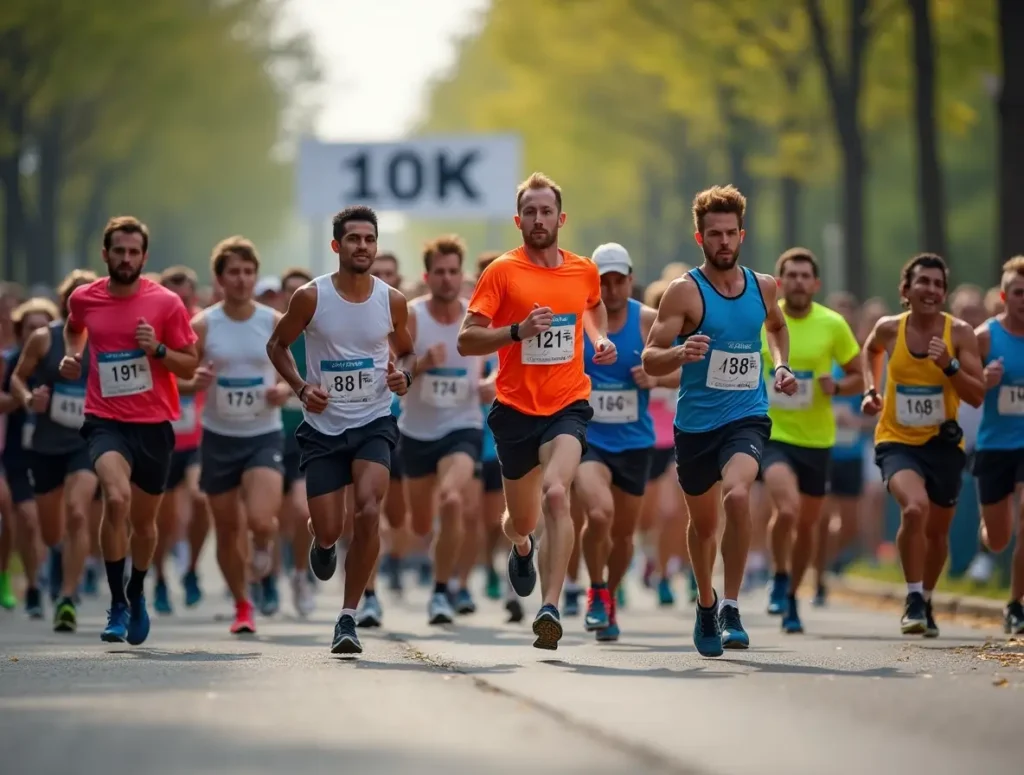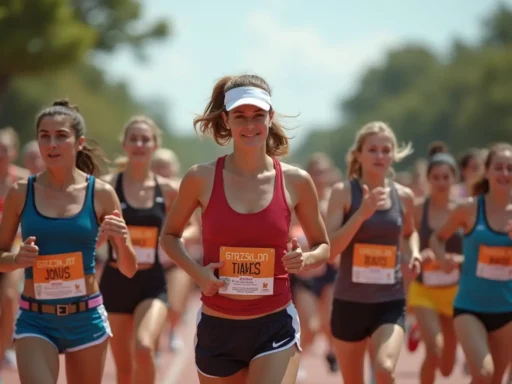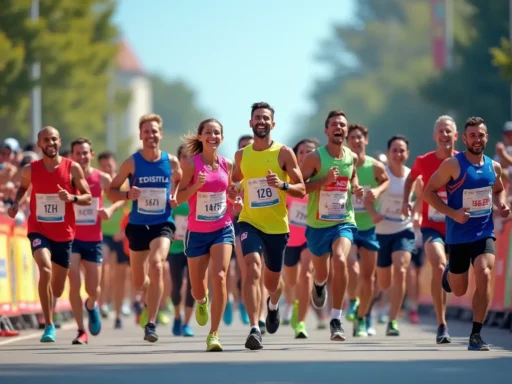Thinking about a 10K challenge? You might wonder how long is a 10k in miles. A 10K run is approximately 6.2 miles in distance. It’s a good goal if you want to improve your running.
Knowing the distance of a 10K in miles is key to getting ready for the race. It helps you make a training plan that fits you.

Whether you’re an experienced runner or new to it, knowing the distance is important. It lets you set achievable goals and see how you’re doing. In this article, we’ll cover 10K running, including the distance, training, and pacing. Ready to learn more and take on the challenge? Keep reading.
Table of Contents
Understanding the 10K Distance
When you ask how long is a 10k in miles, the answer is 6.2 miles. This distance is a popular goal for runners. It’s for everyone, from beginners to experienced athletes. The 10K is the same as 10,000 meters, which is 25 laps on a 400-meter track.
The 10K is loved because it’s challenging yet reachable. Many runners see it as a way to test their endurance. To grasp the 10K, knowing how to convert metric to imperial is key.
The Metric to Imperial Conversion
In most countries, the metric system is used for distance. But in the U.S., imperial measurements are more common. To convert meters to miles, remember: 1 meter is about 0.00062 miles. So, 10,000 meters equals 6.2 miles.
Why the 10K Distance Became Popular
The 10K gained popularity because it’s both accessible and challenging. It’s a distance that suits runners of all levels. It’s also a great way to improve endurance and speed, appealing to many runners.
Common Race Variations
There are many types of 10K races, like road, trail, and track races. Each has its own challenges and requirements. Runners can pick the race that fits their goals and preferences. Whether aiming for a fast time or just finishing, there’s a 10K race for you.
| Distance | Meters | Miles |
|---|---|---|
| 5K | 5,000 | 3.1 |
| 10K | 10,000 | 6.2 |
| Half Marathon | 21,097 | 13.1 |
How Long Is a 10K in Miles: The Exact Calculation
To figure out how long is a 10k in miles, we need to convert kilometers to miles. Since 1 kilometer is about 0.6 miles, we multiply 10 kilometers by 0.621371. This gives us about 6.21371 miles.
This means a 10K run is roughly 6.2 miles. Knowing this is key for runners, whether you’re new or experienced. It helps you get ready and pace yourself right.
If you’re training for a 10K, knowing the distance in miles helps. It lets you understand what to expect and set goals for your finish time.
| Distance in Kilometers | Distance in Miles |
|---|---|
| 10K | 6.21371 miles |
| 5K | 3.10685 miles |
| 1K | 0.621371 miles |
Knowing the distance of a 10K run in miles helps you prepare better. Stay hydrated, train often, and pace yourself for a great 10K experience.
Popular 10K Races Around the United States
Wondering how long is a 10k in miles? It’s about 6.2 miles. With over 3,513 10K races in the U.S., you’ll find something that fits your interests and skill level. Whether it’s a big city event, a seasonal race, or a charity run, there’s a race for everyone.
Some famous 10K races include the Peachtree Road Race in Atlanta, the Vancouver Sun Run, and the Bolder Boulder. These races draw thousands of runners, with the Peachtree Road Race seeing over 55,000 participants in 2011. Entry fees vary, from $10.54 to $274.00, based on the event and when you sign up.
Major City Events
Major city events offer a thrilling experience. These races often have a competitive vibe, with top runners vying for prizes. For instance, the World’s Best 10K has annual prizes over $100,000.
Seasonal Races
Seasonal races are popular, happening all year. The Winter Run Series, for example, has a series of 10K races in winter. Entry fees range from free to $55.15.
Charity 10K Events
Charity 10K events let you help others while reaching your running goals. Many races support local charities, giving a portion of entry fees to good causes. When looking for a 10K race, choose one that supports a charity you believe in.
Training for Your First 10K
When training for a 10K, being consistent and patient is crucial. A good plan helps you get better at running and run faster. Experts say beginners should mix running, strength training, and rest. They should also slowly increase their running distance over time.
A typical 10K training plan lasts 8 to 10 weeks. You’ll run 3 to 4 times a week. This slow build-up helps avoid injuries. As you near the race, add tempo runs, interval training, and long runs to improve your speed.
Here are some tips for training for a 10K:
- Begin with shorter runs and slowly build up your distance over time.
- Incorporate rest days and cross-training to avoid burnout
- Focus on proper nutrition and hydration to fuel your body
- Listen to your body and adjust your plan as needed
Remember, training for a 10K is a journey. It’s important to stay motivated and committed to your goals. With hard work and determination, you can have a successful and fun 10K experience.

Essential Gear for 10K Running
Getting ready for a 10K run? The right gear can really help. It’s all about finding clothes and accessories that are comfy, supportive, and boost your performance.
Dressing in layers is key. It lets you adjust to temperature changes during the race. Wear clothes that feel 20 degrees warmer than the actual race temperature. Also, choose moisture-wicking technical fabrics over cotton to avoid chafing and keep cool.
Proper Running Shoes
Finding the right running shoes is crucial. Super shoes are popular for their light weight and energy return. But, they might cost more. You can also consider racing flats and track-specific shoes, like the Nike ZoomX Dragonfly, for competitive runners.
Performance Clothing and Accessories
Performance clothes, like running-specific socks, help prevent blisters and chafing. Don’t forget race belts and sunglasses for sunny days. Always test your gear and clothes during training to ensure comfort and avoid race-day problems.
| Accessory | Purpose |
|---|---|
| Running-specific socks | Minimize blister formation and chafing |
| Race belts | Carry essentials during the race |
| Sunglasses | Protect eyes from the sun |
Investing in the right gear can improve your performance and safety. Choose what fits your needs and test it before the race. This way, you’ll enjoy your run more.
Building Your 10K Training Schedule
Creating a 10k training schedule starts with knowing your fitness level and running experience. A good plan helps you move from where you are to finishing a 10K race. Beginners should start with 2 runs a week, each lasting 30 minutes, and then increase both.
A typical 10k training schedule mixes running, strength training, and rest. It should include 2 to 4 runs a week, lasting 30 to 75 minutes. It’s important to slowly increase your running by 8-10% each week to avoid injuries. Easy running should make up 80% of your training, with fast running making up 20%.
Here are some general guidelines for building your 10K training schedule:
- Start with 2-3 runs per week and gradually increase the frequency and duration
- Incorporate strength training and rest days to avoid injuries
- Incrementally increase your running mileage by no more than 8-10% per week
- Focus on easy running for 80% of your training time and fast running for 20%
Remember, being consistent and patient is crucial when building your 10K training schedule. With a well-structured plan and dedication, you’ll be ready for your first 10K race soon. A 10K training schedule is a personalized plan to reach your running goals. With the right approach, you can create a schedule that suits you and helps you succeed.
Nutrition and Hydration Strategy
Getting ready for a 10K run means focusing on nutrition and hydration. The right mix can boost your performance and make the race more enjoyable. A 10K race is about 60 minutes long. In that time, your body uses stored glycogen for energy.
Here are some tips for 10k nutrition and hydration:
- Eat a balanced meal with carbs, protein, and fats 2-3 hours before running.
- Drink 500ml of water with 250mg of sodium before starting.
- Don’t eat too much or heavy food close to the race to avoid stomach issues.
It’s important to stay hydrated during the race. Drink about 300 ml of water every 15 minutes. You might also want to use an Oral Rehydration Solution (ORS) with Sodium, Potassium, Calcium, and Magnesium. Most runners don’t need to eat during a 10K unless it takes over 90 minutes.
| Nutrition and Hydration Tips | Recommendations |
|---|---|
| Pre-race meal | Complex carbohydrates, protein, and healthy fats 2-3 hours before the race |
| Hydration | 500ml of water with 250mg of sodium before the race |
| During-race hydration | 300 ml of hydration every 15 minutes |
By using these tips, you can improve your 10K performance. You’ll also reduce the chance of stomach problems and have a great race.

Common 10K Racing Mistakes to Avoid
As you get ready for your 10K race, knowing common 10k racing mistakes is key. Not training at race pace is a big mistake. It can really hurt your performance. Also, not adjusting your training to fit the race time can make you less ready.
Other mistakes include starting too fast. Try to keep your first mile pace in check. Not testing your gear in different weather, like rain, can cause blisters and chafing. This might take about 2 weeks to heal.
A good warmup is important. It should include easy runs, drills, and time for bathroom breaks. This can help you feel more ready and perform better on race day.
Training Errors
- Not incorporating training at race pace
- Insufficient core-strengthening and flexibility exercises
- Not transitioning training schedule to match race time
Race Day Blunders
- Going out too fast
- Not testing gear in various conditions
- Not having a structured warmup
Knowing these common 10k racing mistakes helps you avoid them. Stay focused and don’t let nerves get in the way. With the right training and prep, you can have a great 10K race.
| Mistake | Consequence |
|---|---|
| Not incorporating training at race pace | Significantly hindered performance |
| Going out too fast | Reduced overall race performance |
| Not testing gear in various conditions | Issues like blisters and chafing |
Pacing Strategies for Different Skill Levels
Understanding your skill level is key when it comes to 10k pacing strategies. Beginners aim to finish the race, while intermediate and advanced runners target specific times. Most runners finish between 30-60 minutes, with the fastest being highly competitive and the slowest being newer or recreational.
To create an effective 10k pacing strategy, consider these factors:
- Average pace needed for your target finish time
- Your current fitness and weekly mileage
- How intense and frequent your training is
For example, aiming for a sub-60 minute finish means you need to run at about 6 minutes per kilometer. To finish in 45 minutes, you’ll need to run at 4 minutes per kilometer.
Here’s a sample pacing plan for different skill levels:
| Skill Level | Target Finish Time | Average Pace |
|---|---|---|
| Beginner | 60 minutes | 6 minutes/km |
| Intermediate | 50 minutes | 5 minutes/km |
| Advanced | 45 minutes | 4 minutes/km |
By knowing your skill level and tailoring your 10k pacing strategy, you can improve your performance. Make sure to balance training with rest and recovery to avoid getting too tired. With a well-planned approach, you’ll enjoy a successful racing experience.
Health Benefits of Training for a 10K
Training for a 10K offers many health benefits. These include physical, mental, and long-term fitness gains. You’ll see improvements in your cardio fitness, muscle strength, and bone density.
Some of the key benefits of 10k training include:
- Improved cardiovascular health
- Increased muscle strength and endurance
- Enhanced mental well-being and mood
- Boosted immune system and reduced risk of chronic diseases
Regular running, like training for a 10K, boosts brain function and cognitive abilities. It helps you stay focused and productive. Adding regular running to your routine can greatly improve your health and well-being.
| Benefit | Description |
|---|---|
| Physical Benefits | Improved cardio fitness, muscle strength, and bone density |
| Mental Health Advantages | Enhanced mental well-being, mood, and reduced stress and anxiety |
| Long-term Fitness Impact | Improved overall fitness, reduced risk of chronic diseases, and increased longevity |
Conclusion: Taking On Your 10K Challenge
The 10K race distance is a thrilling challenge that can boost your fitness and personal growth. It’s great for both experienced runners and beginners. Setting a goal to run a 10K can be a rewarding and life-changing experience.
There’s no single way to tackle the 10K distance. Your training and performance will reflect your unique abilities and goals. Enjoy the journey, listen to your body, and celebrate your progress. With hard work and a positive attitude, you’ll conquer your 10K challenge.
Let the excitement of the 10K distance motivate you to reach new heights. You now have the knowledge to face your 10K challenge with confidence. So, put on your running shoes, aim for the finish line, and start an exciting journey of personal growth and achievement.
FAQ
how long is a 10k in miles?
A 10K race is about 6.2 miles long.
What is the metric to imperial conversion for the 10K distance?
The 10K is about 6.2 miles, since 1 kilometer is 0.62 miles.
Why did the 10K distance become a popular running event?
The 10K became popular because it’s a tough but reachable goal. It’s between the 5K and marathon distances.
What are some common variations of the 10K race?
There are many 10K race types. These include city races, holiday runs, and charity events.
What are some tips for training for a 10K race?
To train for a 10K, build endurance and speed. Follow a plan that increases your running and intensity.
What essential gear is recommended for 10K running?
You’ll need good running shoes and clothes. Also, get a GPS watch and hydration pack.
How should I structure a 10K training schedule?
Make a training plan that slowly increases your running. Include speed work and rest days.
What are the best nutrition and hydration strategies for a 10K race?
Eat carbs before the race and drink water. Replenish after running.
What are some common 10K racing mistakes to avoid?
Avoid training too fast and pacing errors on race day. Start slow and pace well.
How should I pace myself for a 10K race?
Start slow, then keep a steady pace. You can speed up at the end.
What are the health benefits of training for a 10K?
Training improves your heart health and mental well-being. It also boosts your overall health.





Comments are closed.